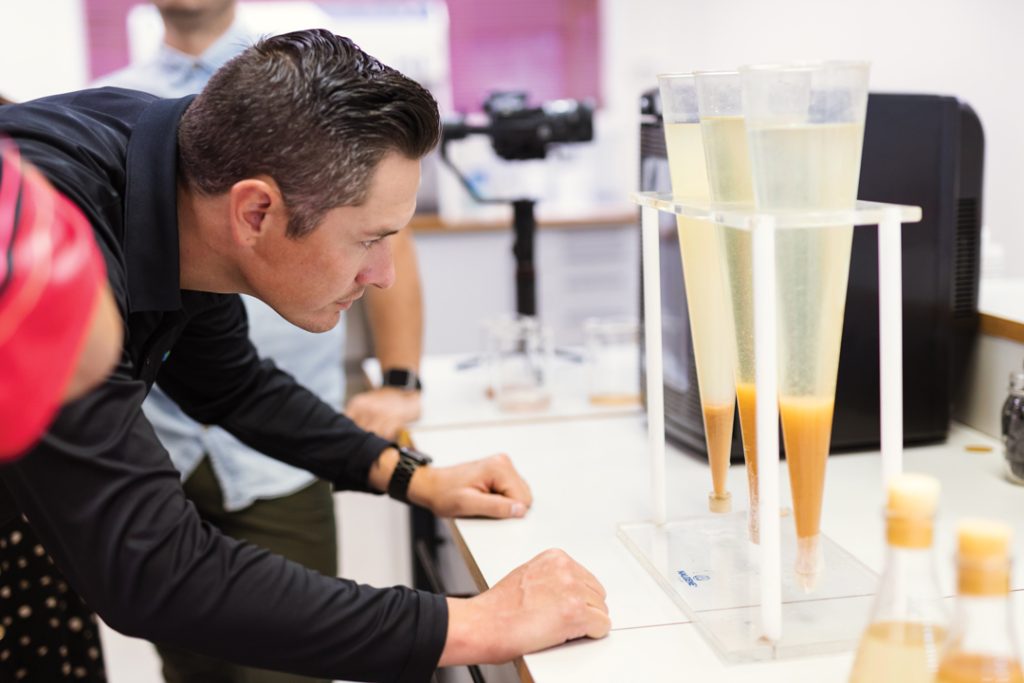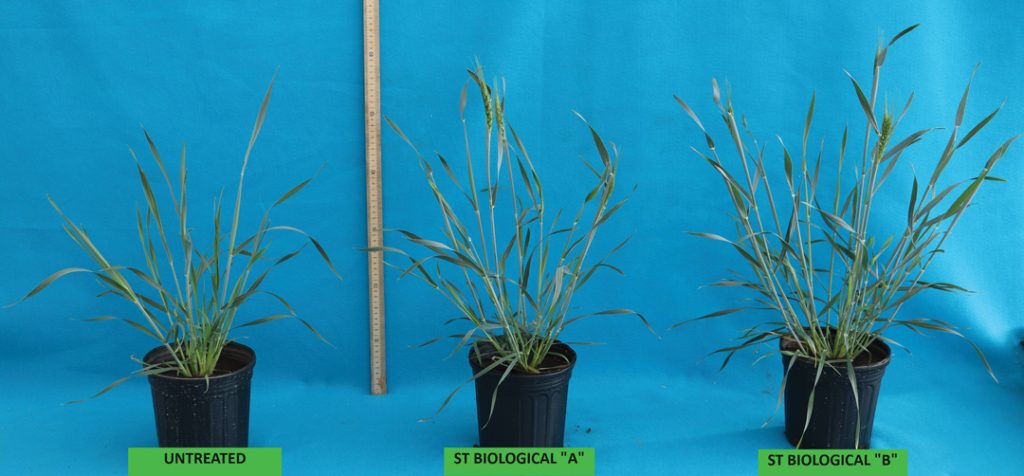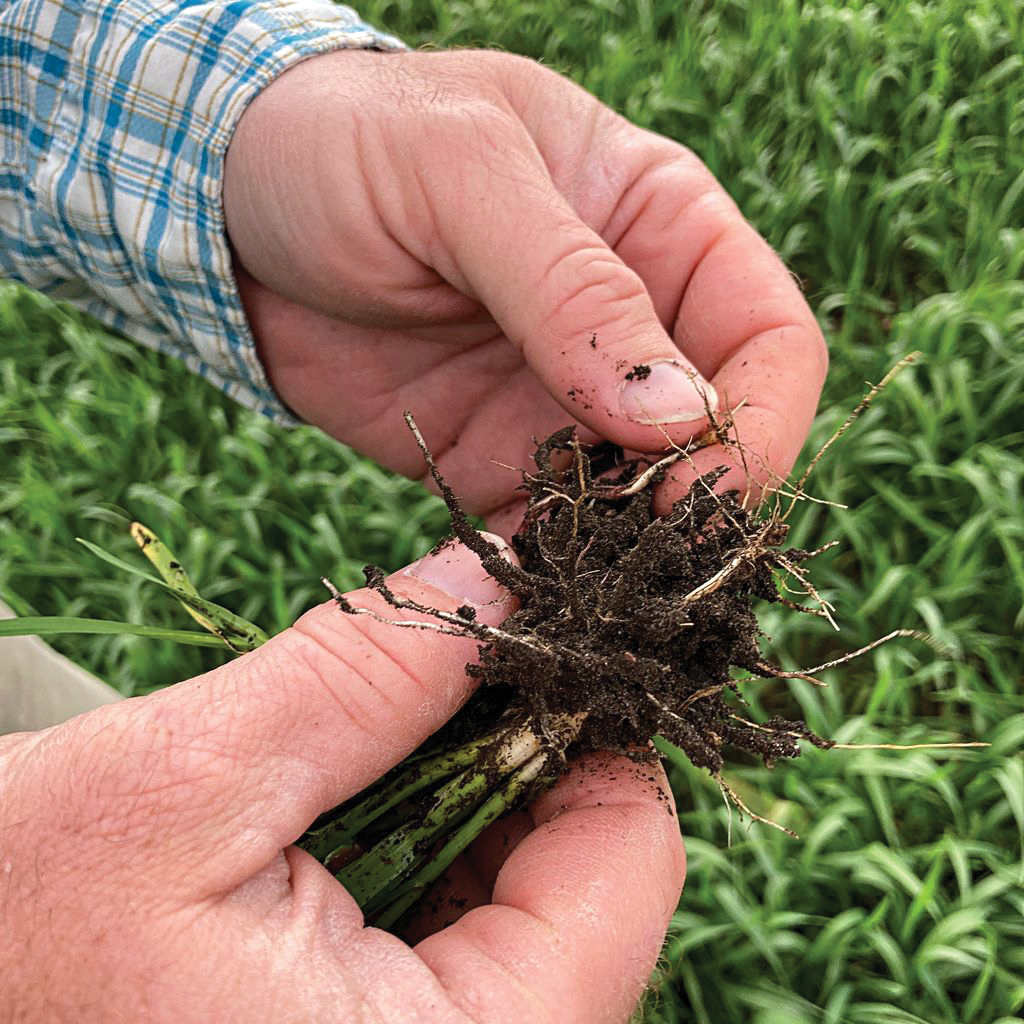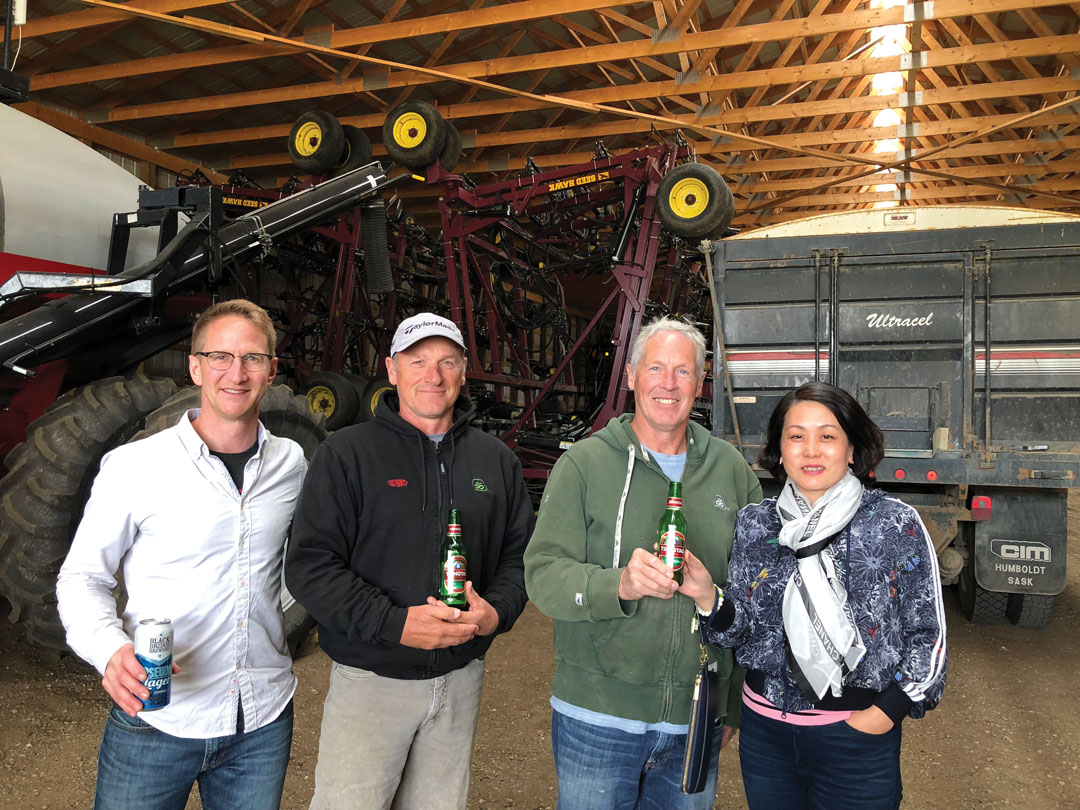BIOLOGICALS BOOM
BY MELANIE EPP • LEAD PHOTO COURTESY OF LAVIE BIO
Substantial growth in the biologicals market has been driven in part by stricter pesticide regulations and by farmers who wish to produce higher yielding, more resilient crops. Biologicals represent a broad category of plant protection products, including biostimulants, biopesticides and biofertilizers. The main difference between chemical products and biologicals is the latter are made of living or naturally occurring materials. Farmers use biologicals as stand-alone solutions or to complement chemical products in their integrated pest management programs to fight disease, insect pests and weed competition. They also use biologicals to improve plant health, some of which make nutrients more available.
According to a recent report from MarketsandMarkets, the agricultural biologicals market is expected to nearly double from US$14.6 billion in 2022 to US$27.9 billion in 2028. A Stratus Ag Research farmer survey focused on biostimulant use and satisfaction, however, reveals that Canadian farmers remain skeptical. Widespread adoption has been constrained by several factors such as higher costs associated with biological products, limited third-party research and a lack of product-use knowledge. As well, major corporate players in the biologicals category face big challenges. As market competition grows, they must achieve consistent and reliable results in the field, navigate regulatory scrutiny and develop packaging that ensures product survivability.
USE AND SATISFACTION
Stratus Ag Research has tracked the use of biological products in Canada since 2022. In a recent survey, it asked farmers about their use of biostimulants. The survey defined biostimulants as products that contain substances or microorganisms whose marketed function is to stimulate natural processes that enhance nutrient uptake, nutrient-use efficiency, tolerance to environmental stress and/or improve crop quality. The survey did not include rhizobial inoculants for pulse crops or nitrogen fertilizer stabilizers. Of the 1,805 farmers surveyed, 1,104 operate in Western Canada. Of these, 26 per cent use biostimulants on their farms.
According to Sarah Healy, one of Stratus’s market research managers, significantly more farmers are now curious about the use of biostimulants than in 2022. “We saw a statistically significant shift from negative attitudes to positive attitudes, and that was among both users and non-users,” she said. “Fewer are unconvinced, reluctant or in the will-never-use or snake-oil categories.” Used by nine per cent of Canadian farmers, beneficial bacteria and fungi was the most common biostimulant type in 2023. This category, said Healy, is dominated by the longstanding use of JumpStart in Western Canada. For use with a broad range of crops that includes canola and all wheat, this seed treatment contains a beneficial fungi that makes soil phosphate more available for uptake by the plant. A further eight per cent of farmers reported using a nitrogen-fixing biological that year. This category, led by Envita, saw slightly lower market penetration on the Prairies.
The survey found 56 per cent of Canadian farmers are satisfied with the biostimulant brand they used in 2023, and overall use was stable compared to 2022. Of those surveyed, 23 per cent used a biological product in 2023. The protein hydrolysate category had the highest level of satisfaction, while contentment with seaweed extracts also showed marked improvement. Nitrogen-fixing biologicals saw the fewest satisfied users and the most dissatisfied users. Satisfaction with nitrogen-fixing biologicals was higher in 2023 than it was in 2022, however.
Stratus also conducts an annual study of retailers to gauge their willingness to recommend these products. Its 2023 survey results were set to be released July 12. Healy noted retailers are also increasingly confident in their assessment of biologicals, and 2023 saw a slight increase in perceptions of strong performance.
“However, collectively across all biological products sold, on average only 45 per cent of the time were retailers able to provide a good to excellent performance rating,” Healy pointed out. “Most commonly we find that there is still hesitation and uncertainty around performance. We know that confidence in these biostimulant products is really going to make or break whether or not they’re going to recommend them.”
BIOLOGICAL REGULATION
Around the world, authorities generally recognize biological plant protection products as beneficial tools that differ from their chemical counterparts. However, regulatory requirements and review processes are often inconsistent. Biologicals and conventional chemicals may be registered in a similar manner, or not. Data requirements can be minimal or the registration process ill-defined.
In Canada, biologicals are reviewed by either the Pest Management Regulatory Agency (PMRA) or the Canadian Food Inspection Agency (CFIA). Biostimulants fall under the same regulatory framework as fertilizers and are registered by the CFIA, while biopesticides fall under the PMRA’s purview. “Sometimes it’s tied to the actual product,” said Pierre Petelle, president and CEO of CropLife Canada, a trade association representing members of the pesticide and plant breeding sectors. “Other times, it’s tied to the claims they’re trying to make about the product.”
This approach has illuminated new challenges as single ingredients may have several uses. For instance, there are now two products on the market that contain the exact same biological ingredient. During the registration process, one was reviewed by the CFIA as a biostimulant. The other, a biopesticide, fell to the PMRA.
“One of the issues that’s been raised to us is a product that goes through the PMRA stream, it’s much more rigorous. There’s data, there’s a review, there’s costs involved, versus the CFIA approach, which is a lighter touch,” said Petelle.
Such situations raise questions of fairness. If a farmer knows the two products are the same, though the claims are different, they could simply buy the biostimulant for use as a biopesticide. This would give an unfair advantage to the company that went through the PMRA process. “We don’t think it’s a widespread, significant issue, but there have been a couple of examples raised to us where that’s the case,” said Petelle. “We’re discussing with our members whether anything can or should be done.”
CropLife works to ensure Canadian biostimulant regulations line up with those in export markets. While assuring farmers they can use these products without repercussion, clear regulatory requirements and processes incentivize biological manufacturers to set up shop in Canada.
The major players have, in recent years, invested heavily in the development of new biological products, which signals they’re here to stay. “In my experience, these are very savvy companies which are very good at reading market drivers,” said Petelle. “The fact so many of them have made very significant expenditures in this area tells me this isn’t just a passing fad.” Their presence in the marketplace should further reassure farmers of the efficacy of these products, he added. “Companies like Bayer, Syngenta, Corteva and our other members can’t afford to be putting products that just don’t work in the hands of farmers.”

CREDIBILITY AND TRUST
For 15 years prior to entering the agricultural biologicals business in 2016, Joshua Day Chief, CEO of AdvancedAG, conducted post-secondary research on the use of microbes in wastewater management. Through his experience at parent company AdvancedWater, he knew microbes could be used to cycle nutrients in wastewater and wondered if the same function could be performed in crop production. He also learned farmers in developing nations have used microbial mixtures in banana and pineapple production to enhance yield and quality and boost disease resistance. He imported this biotechnology via a U.S. supplier to assess its potential use in broadacre farming.
“We started doing research on these particular bacteria to see how we could use them to make nutrients more available to plants,” said Day Chief, whose company is in Raymond. In 2016, a 50-acre field trial with peas just outside Medicine Hat produced an obvious positive response, unfortunately the crop was hailed out before data could be collected. “But there was something there, and the farmer saw that,” said Day Chief.
The next year, AdvancedAG conducted more replicated trials to determine how best to apply the product, at what rate and to which crops. Though initial results were positive, more research was needed to allow the company to determine how the bacteria interact with plants to improve their health, and genetic sequencing on the bacteria will further enhance this understanding.
AdvancedAG now markets two products. ACF-SR contains a highly concentrated blend of five microbes that stimulate plant growth. The company claims it enhances germination, promotes plant growth, increases yield and improves soil health. SRP, also a microbe blend, is claimed to optimize plant health, improve disease resistance and boost nutrient uptake. ACF-SR is soil applied, while SRP is foliar applied.
AdvancedAG is currently developing seed treatments as well. The company employs dozens of representatives who assist farmers across Canada and in parts of the U.S. To choose a product becomes more difficult as new biological solutions come to market. “If I’m a farmer, and I don’t have a wealth of knowledge or haven’t spent hours reading about the differentiation of all these products, my head would be spinning,” said Day Chief. “I wouldn’t even know what to try.” He recommends farmers start by defining their goals. These may be quicker germination, enhanced root development or to save on the cost of fertilizer. Farmers should then seek data produced by reliable third-party research.
Before selecting a biological, he also recommends farmers talk to their peers. What has worked for them? “I always say you’re one farmer away from knowing every farmer in Canada,” said Day Chief. “People talk, and that’s how our business has grown. Word of mouth has been really important.”
Grain farmer Ken Farion has used biologicals on his 4,000- acre farm near Vegreville for six years. Farion said he has seen enhanced germination, and the resulting crops are healthier though he uses fewer inputs. In fact, since adopting ACF-SR, he hasn’t used any other seed treatment or fungicide, and dropped fertilizer use by an estimated 20 to 30 per cent. “If conditions are exceptional, we will top dress if need be,” he said.
Farion added his soil is healthier, too, and likes that he knows exactly which five bacteria the product contains and how they work throughout their lifecycle. “I go into everything with an open mind. Some things are disappointing, and some aren’t. This is one that’s really caught our attention. We’re really happy with the performance.”
Consistent performance is crucial to get farmers on board. But as the Stratus survey indicates, only 37 per cent are willing to commit to two or three years using the brands they adopted in 2023. In fact, most biostimulant categories tend to have a higher percentage of users who are not committed. Commitment is strongest for protein hydrolysates and weakest for nitrogen-fixing biologicals.
Russ Putland is an executive vice-president and general manager of Lavie Bio, a subsidiary of Evogene, a bioinformatics and big data company. Putland emphasized the No. 1 reason farmers don’t adopt biologicals is skepticism. Lavie Bio has two key stakeholders, Corteva and ICL, a fertilizer company based in Israel. “You ask yourself, well, why are they skeptical?” said Putland. “They adopt new technology better than just about any industry. It’s because we failed. If companies are honest with themselves, the first generation of biologicals from 20 years ago went out early and with mediocre results.”
To take the guesswork out of product development, Lavie Bio adopted cutting-edge technology that allows scientists to better understand which microbes work well together and how they interact with their host crops.
The partnership with Corteva has proven particularly lucrative for Lavie Bio, as Corteva contributes an extensive microbe library. This database has been integrated into Lavie Bio’s proprietary Biology Driven Design (BDD) platform, a tool that facilitates and accelerates the development of new microbiome-based products. BDD decodes complex microbiome–host interactions and maps individual microbes according to function, efficacy and shelf life. With the help of artificial intelligence, the platform uses this big data to design new products based on desired outcomes.
Lavie Bio has a number of biostimulants and biopesticides in the development pipeline, but only Yalos has reached commercialization. The biostimulant is the product of a BDDsuggested pairing that the company’s in-house scientists hadn’t considered. “AI suggested that these two were the combination that would work, and clearly they did,” said Putland.
Yalos is a bioinoculant suitable for spring wheat, durum, barley and winter wheat. The product enhances nutrient availability and efficiency, increasing a plant’s natural defence mechanisms in times of stress, said Putland. It contains two microbes, one to enhance nutrient uptake and availability and the other to boost resistance to abiotic stress. The company tested the product in its own greenhouses and followed this with third-party testing. The results were consistent. In commercial trials over multiple years, Yalos bumped wheat yield by an average of six per cent.
Putland believes there’s a big future for biologicals, especially when you consider the limited number of new synthetic actives discovered over the last couple of decades.
“Nature is so diverse. There are billions of microbes that exist within nature,” said Putland. “We’re not looking to discover new synthetic compounds. We’d rather explore and understand the diversity that already exists, then we can amplify a microbe’s positive functions for use in other plants. Leveraging microbes that exist in nature tends to be a more efficient path than attempting to discover new synthetic compounds.”

CONSISTENCY IS KEY
BASF Canada now exclusively offers inoculants for pulse and soybean crops. However, its U.S. R&D team continues to develop biologicals in further crops such as corn and soybeans and is testing newly developed products such as a biofungicide for use in North American cereals.
The achievement of consistent results poses a significant challenge for developers and users of biological products because they are comprised of living organisms that are sensitive to fluctuation in environmental conditions. In response, manufacturers such as BASF put great effort into every aspect of product marketing and development. In biologicals, this includes package design that protects product quality as well as clear communication of proper usage guidelines.
Prior to commercialization, products are screened in the lab and then tested in both small- and large-scale, multiyear, replicated field trials under varying conditions. They are further tested with large-scale commercial equipment with the aim to assess application techniques and refine best practices, said Natalie Campbell, biological seed treatment brand manager at BASF Canada. “Once we go to launch, our marketing team, technical team and sales team fully understand the best management practices so we can support our growers with recommendations to ensure the best possible performance of the product.”
In Western Canada, BASF employs four specialists it has dubbed ACES (AgSolutions Crop Establishment Specialists) who assist farmers with seed treatment, inoculants and biological products. Team member Ryan Dunn is one such specialist. “We know application impacts survivability and compatibility,” he said. “We have tested and know different tips and tricks to ensure maximum survivability, and we’ve been trained on all the equipment.”
BASF also works to create packaging solutions for its living products. “Unique to biologicals is the level of innovation and research that has to go into packaging to ensure the survivability of the product leaving the production site to application to planting,” said Nicole Fox, a BASF technical marketing specialist. To ensure optimum survivability of the product, Fox said multiple batches are produced and packaged at the company’s manufacturing plant and undergo testing for biological survivability in a range of packages. “This testing continues for the proposed shelf life of the product under variable temperature and storage conditions to ensure our minimum label guarantee is maintained in package, as well as on seed,” she said. If its established parameters are not met, further development is carried out, she added.
Biologicals appear to be here to stay. As corporate product portfolios expand, it will be important for manufacturers to address the main barriers to uptake. Though skepticism persists, it may dissipate as more farmers adopt the new technology. Product success hinges on the regulatory frameworks under which they are registered and on access to third-party data that supports product claims. Clear communication on product use and support from boots-on-the-ground technicians should also help boost adoption.







Comments